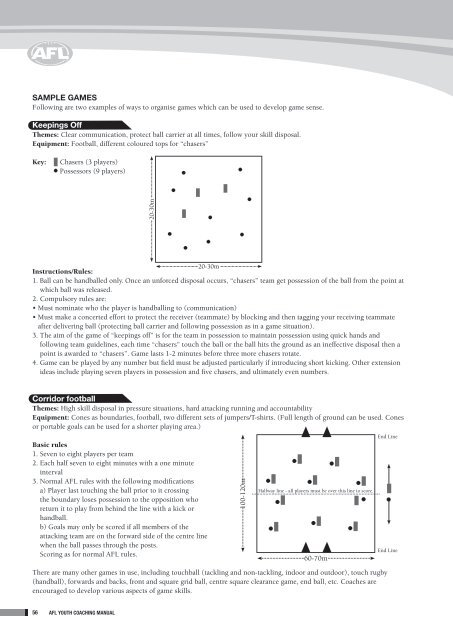2012 Youth Coaching Manual - AFL Community
2012 Youth Coaching Manual - AFL Community
2012 Youth Coaching Manual - AFL Community
Create successful ePaper yourself
Turn your PDF publications into a flip-book with our unique Google optimized e-Paper software.
SAMPLE GAMES<br />
Following are two examples of ways to organise games which can be used to develop game sense.<br />
Keepings Off<br />
Themes: Clear communication, protect ball carrier at all times, follow your skill disposal.<br />
Equipment: Football, different coloured tops for “chasers”<br />
Key: <br />
Chasers (3 players)<br />
Possessors (9 players)<br />
20-30m<br />
20-30m<br />
Instructions/Rules:<br />
1. Ball can be handballed only. Once an unforced disposal occurs, “chasers” team get possession of the ball from the point at<br />
which ball was released.<br />
2. Compulsory rules are:<br />
• Must nominate who the player is handballing to (communication)<br />
• Must make a concerted effort to protect the receiver (teammate) by blocking and then tagging your receiving teammate<br />
after delivering ball (protecting ball carrier and following possession as in a game situation).<br />
3. The aim of the game of “keepings off” is for the team in possession to maintain possession using quick hands and<br />
following team guidelines, each time “chasers” touch the ball or the ball hits the ground as an ineffective disposal then a<br />
point is awarded to “chasers”. Game lasts 1-2 minutes before three more chasers rotate.<br />
4. Game can be played by any number but field must be adjusted particularly if introducing short kicking. Other extension<br />
ideas include playing seven players in possession and five chasers, and ultimately even numbers.<br />
Corridor football<br />
Themes: High skill disposal in pressure situations, hard attacking running and accountability<br />
Equipment: Cones as boundaries, football, two different sets of jumpers/T-shirts. (Full length of ground can be used. Cones<br />
or portable goals can be used for a shorter playing area.)<br />
Basic rules<br />
1. Seven to eight players per team<br />
2. Each half seven to eight minutes with a one minute<br />
interval<br />
3. Normal <strong>AFL</strong> rules with the following modifications<br />
a) Player last touching the ball prior to it crossing<br />
the boundary loses possession to the opposition who<br />
return it to play from behind the line with a kick or<br />
handball.<br />
b) Goals may only be scored if all members of the<br />
attacking team are on the forward side of the centre line<br />
when the ball passes through the posts.<br />
Scoring as for normal <strong>AFL</strong> rules.<br />
There are many other games in use, including touchball (tackling and non-tackling, indoor and outdoor), touch rugby<br />
(handball), forwards and backs, front and square grid ball, centre square clearance game, end ball, etc. Coaches are<br />
encouraged to develop various aspects of game skills.<br />
100-120m<br />
Halfway line - all players must be over this line to score.<br />
60-70m<br />
End Line<br />
End Line<br />
56 <strong>AFL</strong> <strong>Youth</strong> <strong>Coaching</strong> <strong>Manual</strong>

















